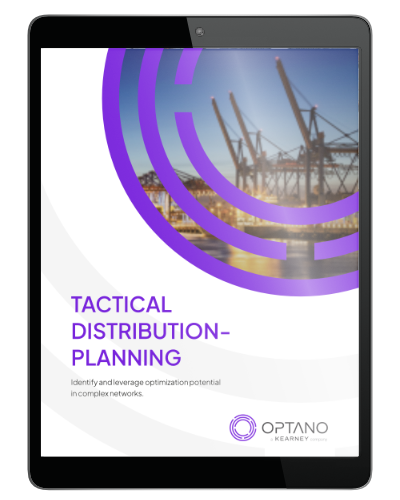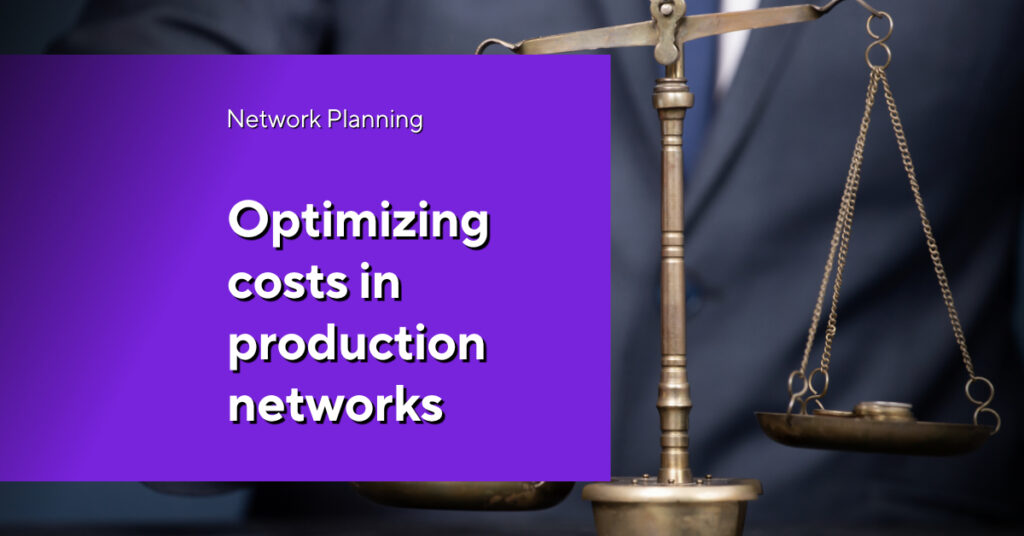Optimizing Transport Modes
Speed or cost? Direct or consolidated? When making decisions about transport modes in distribution logistics, planners often face conflicting objectives. Choosing between rail or air freight, FTL (Full Truck Load) or LTL (Less-than-Truckload) is not merely an operational issue – it significantly impacts a company’s profitability, service quality, and environmental footprint.
But how can you determine the optimal mode in a complex network with hundreds of routes and constantly changing requirements? The answer lies in mathematical optimization—a method that enables informed decisions based on data, scenarios, and competing objectives.
The reality of distribution planning: conflicting goals and uncertainty
Cost, service levels, and sustainability in tension
In many organizations, transport mode selection happens under uncertainty and time pressure. Planners must reconcile opposing goals: reducing transport costs while maintaining service levels, and simultaneously meeting sustainability targets by lowering CO₂ emissions. These requirements often contradict each other. For example, switching to rail transport can significantly reduce emissions but may increase transit times, jeopardizing delivery deadlines.
Carrier performance data is often underutilized in planning
Many companies overlook key metrics such as punctuality rates, damage ratios, or average delays. This leaves efficiency potential untapped. Consider this example: a carrier with an 89% on-time rate may cost 8% more than the cheapest provider, but its reliability can be crucial for time-sensitive deliveries. Such trade-offs can only be made when performance data is systematically collected and integrated into planning.
Complexity of multi-tier networks as an additional hurdle
Modern distribution networks add another layer of complexity. Multi-tier systems with central hubs, regional distribution centers, and thousands of customers create countless possible transport routes. Manually evaluating all these options is virtually impossible. Specialized software is needed to manage this complexity and model trade-offs mathematically.
Mathematical optimization as the methodological core
To make optimal transport mode decisions, more companies are turning to mathematical optimization. This method calculates the best possible solution to a complex decision problem based on defined goals, constraints, and data. In distribution planning, this means identifying the most efficient transport mode for each route – considering cost, time, emissions, and service requirements.
Optimizing transport mode selection with OPTANO
Data integration as the foundation for reliable decisions
A key element of reliable decision-making is integrating all relevant data sources – and this is where OPTANO excels. The planning software combines traditional transport cost data for FTL, LTL, rail, and air freight with qualitative information on carrier performance. Historical punctuality data, damage rates, service level fulfillment, and environmental metrics such as CO₂ emissions per ton-kilometer are systematically captured and included in the optimization. This creates a solid decision-making foundation that accounts for both economic and ecological goals.
Scenario comparison reveals trade-offs
Another major advantage of mathematical optimization is the ability to systematically compare different scenarios. With planning software like OPTANO, companies can analyze how switching from truck to rail affects costs, emissions, and delivery times. They can also simulate changes such as new sustainability goals or carrier outages. These scenarios make trade-offs visible and provide valuable decision support, enabling proactive rather than reactive strategy development.
Mixed-mode strategies as efficiency drivers
Mixed-mode strategies – intelligently combining different transport modes – are particularly effective. A typical example is combining rail and LTL: large volumes are first transported by rail to a regional hub, then distributed via LTL. This strategy leverages the cost and environmental benefits of rail with the flexibility of truck transport. OPTANO identifies where such strategies deliver the greatest value – for example, on high-volume routes with predictable time windows. The software automatically calculates the best mode combinations and shows their impact on cost, emissions, and service levels. Transport mode selection thus becomes a strategic lever for sustainable and efficient logistics.
Measurable impact on cost, emissions, and service levels
Applying mathematical optimization to transport mode selection leads to significant improvements: transport costs can be reduced by an average of 8–15%, and CO₂ emissions by 10–20% – especially through targeted use of rail and intermodal solutions. OPTANO uses mathematical models to uncover these potentials and translate them into actionable measures.
Service quality also benefits: incorporating carrier performance data helps identify reliable partners. This can improve delivery reliability and service levels by 2–5%—often without additional costs. At the same time, OPTANO dramatically shortens planning time: instead of spending weeks on manual evaluations, the solution enables well-informed decisions within just a few hours. This makes optimization not just a theoretical concept, but a practical reality.
More interesting articles

Mathematical optimization is a powerful tool for significantly and sustainably improving planning processes in companies. In existing systems, it can deliver double-digit efficiency gains without requiring compromises in other areas, such as service levels or sustainability. The downside of such systems, however, is that increasing complexity makes them harder to use, and optimization results are often difficult for humans to fully understand.
Optimization makes trade-offs manageable
Transport mode selection is not a minor operational detail – it’s a strategic lever with far-reaching implications. Companies that make data-driven, optimized decisions gain a clear competitive edge. They can improve their cost structure, achieve sustainability goals, and enhance service quality.
Mathematical optimization provides the methodology needed to navigate complex trade-offs and enable informed decision-making. By integrating carrier performance data, simulating various scenarios, and strategically applying mixed-mode strategies, distribution planning becomes not only more efficient but also more resilient and sustainable. In an era where supply chains are under constant pressure to adapt, this capability is critical for long-term success.
Take action now: Optimization starts with the right question
Which routes in your network hold untapped potential? Which mode shifts could reduce costs and support your sustainability goals? And how can carrier data improve the reliability of your supply chain? Whether you’re preparing strategic decisions or improving operational processes – together, we’ll identify the levers to take your distribution planning to the next level.

Find out in the OPTANO fact sheet how companies are using modern decision-making models to master complex challenges in the supply chain: from selecting efficient modes of transport and intelligent warehouse placement to strategic network design. Discover how you can reduce costs, increase service levels, and achieve sustainability goals—all based on reliable analyses rather than gut feelings. Download the fact sheet now and take your network planning to the next level!
To obtain our factsheet, all you need to do is enter your contact details in the space below. A pop-up window will then open to download the whitepaper. Please note that by providing us with your email address, you agree that we may contact you on this topic. You may revoke this agreement at any time by contacting privacy@optano.com.






